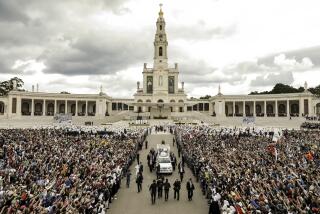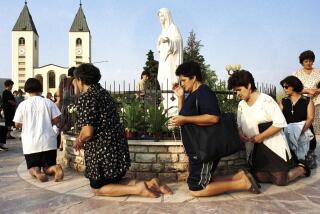Sexual Repression Theory Applied to Sightings : Visions of Mary: Hallucinations?
Reports of miraculous appearances by the Virgin Mary, a recurring popular phenomenon in Roman Catholicism usually treated cautiously by the Vatican, frequently can be explained as hallucinations arising from the loss of loved ones or repressed sexual feelings, a social scientist says.
âIâm constantly amazed at the ease with which well-documented accounts of apparitions can be explained in non-miraculous terms,â Michael P. Carroll, a sociology professor at the University of Western Ontario in Canada, said in a telephone interview.
The most-discussed apparitions currently are those of the mother of Jesus that six teen-agers in the Yugoslav hamlet of Medjugorje say they have experienced almost daily since 1981.
The Vatican confirmed in June that it has urged Italian bishops to discourage pilgrimages to Medjugorje while church investigations continue. Tens of thousands of Roman Catholics have traveled to the out-of-way hillside in southern Yugoslavia, and at least three books have been published favoring the authenticity of the claims.
Carroll said, however, that a tell-tale clue to the psychological origin of the accounts is the information that the first adolescent who said Mary appeared and talked to her had recently experienced the death of her mother and that her father was away working in another country.
âMixed-Up Logicâ
Psychoanalytic studies show that hallucinations in young people are âquite often hallucinations of parents who have recently died,â Carroll said.
The teen-age girl at Medjugorje reportedly saw the Virgin Mary and asked how her mother was. âWeâre dealing with the same sort of mixed-up logic that we find in dreams; the Virgin Mary was a substitute mother, but the association comes out in the question she asks,â he said.
The Stanford-educated scholar has published some of his interpretations in the Journal for the Scientific Study of Religion and is completing a book on the subject for Princeton University Press to be published early next summer.
Potentially the most controversial of Carrollâs theories is his effort to apply Sigmund Freudâs theories of hallucinations and the Oedipus complex as a scientific reason for some Marian apparitions. He said he believes that he is the first to do so.
Freudâs theory of the Oedipal process, greatly simplified, says that young children of both sexes develop their first sexual attachments to their mothers but that girls later transfer their desires to their fathers and wish to have babies by them. The sonâs desire for his mother is repressed, in Freudâs view, because of the sonâs anxiety about the threat of castration by his father. The maleâs desire becomes a (repressed) desire for exclusive access to the mother.
Blocked Impulse
Carroll noted that Freud contended that religious obsessions, including apparitions, arise from a blocked impulse or restrictions that are vented by focusing on old fixations.
In 50 well-documented cases of seers between AD 1100 and AD 1896, Carroll found that 80% of those who said they were visited by Mary were either adolescents âwho lacked any obvious sexual outletâ or celibate adults.
âThese apparitions occur to males because such apparitions are sublimations of the maleâs sexual desire for his mother,â Carroll said, âwhile they occur to females because they provide these females with a way of identifying with Mary and thus enjoying the ultimate Oedipal fantasy.â
For some devout Catholic women, according to this theory, the ultimate fantasy would be sexual intercourse with the father--in this case, the Father in Heaven, despite biblical/doctrinal teaching that it was a spiritual impregnation rather than a physical union of God with Mary.
Carroll said he believes that the theory was reinforced when he found that 93% of male seers saw no male figure along with Mary in their visions.
âExclusive Sexual Accessâ
âThe young boyâs Oedipal wish is not simply to have sexual access to his mother but rather to have exclusive sexual access to her,â Carroll wrote. By contrast, 50% of the female seers saw an adult male (the adult Jesus or a male saint) with Mary, he said.
Although the visions are not overtly sexual, Carroll said, âthere is always an element of disguiseâ in visions and dreams, according to psychoanalytic research. The male seer, for instance, âwould not accept an overly sexy Mary,â he suggested.
Nevertheless, when females have reported visions of Jesus Christ, he said, we âquite oftenâ find disguised sexual imagery.
Carroll contended unapologetically that the social scientist, as opposed to the religious believer, must view apparitions as either hallucinations (when the seer is the only person perceiving anything) or illusions (when images are stimulated by a light, statue or other object).
Psychologist Paul Pruyser of the Menninger Foundation in Topeka, Kan., and Princeton Theological Seminaryâs Donald Capps, editor of the Journal for the Scientific Study of Religion, both said they find Carrollâs thesis on the Freudian basis for Marian apparitions well-argued.
Skepticism in Vatican
Although visions of Mary and accounts of her âmessagesâ have inspired widespread devotions among Catholics and claims of miraculous cures at Marian shrines, the Roman Catholic hierarchy tends to treat reported appearances skeptically. Over the centuries, only a small number of thousands of alleged apparitions have been blessed by Rome as worthy of belief, and even then the church does not require belief.
Jesuit Father Joseph J. Farraher of San Francisco, who answers fellow priestsâ questions in a Catholic magazine column, said in an interview that even when the Vatican extends its blessings to accounts such as the one reported in Lourdes, France, in 1858, the church is âreally only approving of the message; they are not guaranteeing that there was an appearance by Mary.â
Farraher said the church tries to âexclude any other explanation before it accepts (what was said) as supernatural. They investigate whether it is a case of self-deceit, evil spirits or something else.â
Regardless of the church hierarchyâs rejection of some alleged appearances, Farraher said, âanything that seems to be supernatural still draws thousands of people.â
The Diocese of Brooklyn has termed inauthentic the purported visions of Mary by Veronica Lueken, a Bayside, N.Y., housewife. In Chile, the archbishop of Valparaiso discounted as baseless in 1983 the sightings reported by a teen-age boy.
In Medjugorje, the local bishop, Pavao Zanic, has claimed for years that the young people reporting apparitions were victims of âcollective hallucinations.â The recent letter from the Vatican to Italian bishops said that Zanic said the accounts âcreate confusion among believersâ and hinder the church investigation of the sightings.
Mary often âspeaksâ to seers, who are usually ordinary lay Catholics, bypassing the official church, which is supposed to be the mediator between God and the faithful. Thus, some observers have said that questions of religious authority influence the Vaticanâs reluctance to validate visions as much as its concern about verifying the appearances.
Carroll said he has not studied the politics of church approval but has concentrated on trying to see why individuals say they see and hear the Virgin Mary.
The sociologist said he has bypassed the alleged 16th-Century apparition of Our Lady of Guadalupe to Juan Diego, a famous devotion in Mexican Catholicism. âThe first authentic documents which mention the apparition do not appear until over 100 years after the reported apparition, even though the shrine has been there a long time,â he said.
Other Reports Heard
As to why groups of youths could report roughly the same encounters with Mary--at Fatima, Portugal (in 1917), Medjugorje and in other instances, Carroll said, âThe hallucination in one child can prompt hallucinations in other children if there is a supportive environment.â
The youthsâ stories are often similar because, as at Fatima, âthe children have a chance to give reports in each otherâs presence,â and the accounts of famous Marian appearances are well-known in devout Catholic circles, he said.
Carroll suggested that the apparitions at Fatima and Lourdes both reflect the image of someone other than Mary because of the principal seerâs longing for a loved one.
âClearly the person at Fatima who had the original vision was Lucia Santos, whose memoirs written later give clues to what induced the visionâ--a low point in her life when her older sisters left home to marry or go to work. âShe had an apparition of a woman who was not initially identified as the Virgin Mary but as one who sounds a lot like one or more of her older sisters,â he said.
At Lourdes, 14-year-old Bernadette Soubirous had to leave her beloved aunt and godmother to go briefly to her foster parentsâ home, where she was unloved and then lived again with her poverty-stricken parents. It was then when she began having visions.
The distinctive dress worn by the figure in the apparition, Carroll said, leads to the conclusion that the hallucination was âan attempt to gratify Bernadetteâs desire to be living once more in comfort with her loving godmother.â
More to Read
Sign up for Essential California
The most important California stories and recommendations in your inbox every morning.
You may occasionally receive promotional content from the Los Angeles Times.










